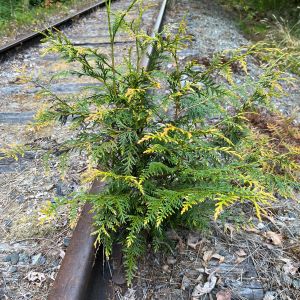- Thuja plicata Donn ex D. Don (plants.sc.egov.usda.gov)
Cypress family (Cupressaceae). Native trees growing to 50 (-75) meters tall, often buttressed at base, with a conical to irregular crown, old individuals frequently with many leaders and many dead spike tops; branches arching, branchlets pendent, flattened, in fan-shaped sprays; bark gray to reddish-brown, 10-25 mm thick, fibrous, separated into flat, connected ridges. Leaves are evergreen, scale-like and sharply pointed, (1-) 3-6 mm long, opposite in alternating pairs (in 4 rows), glossy green above, white-striped on the lower surface, with a spicy fragrance when crushed. Seed cones are ellipsoid, 10-14 mm long, brown; seeds 8-14 per cone, 4-7.5 mm long, with lateral wings about as wide as the body. The common name pertains to the western distribution and cedar-like appearance.
- Thuja plicata (Wikipedia)
Thuja plicata is a large evergreen coniferous tree in the family Cupressaceae, native to the Pacific Northwest of North America. Its common name is western redcedar in the U.S. or western red cedar in the UK, and it is also called pacific red cedar, giant arborvitae, western arborvitae, just cedar, giant cedar, or shinglewood. It is not a true cedar of the genus Cedrus. T. plicata is the largest species in the genus Thuja, growing up to 70 metres (230 ft) tall and 7 metres (23 ft) in diameter. It mostly grows in areas that experience a mild climate with plentiful rainfall, although it is sometimes present in drier areas on sites where water is available year-round, such as wet valley bottoms and mountain streamsides. The species is shade-tolerant and able to establish in forest understories and is thus considered a climax species. It is a very long-lived tree, with some specimens reaching ages of well over 1,000 years.
 Western red cedar by the rail
Western red cedar by the rail Western red cedar by the rail
Western red cedar by the rail